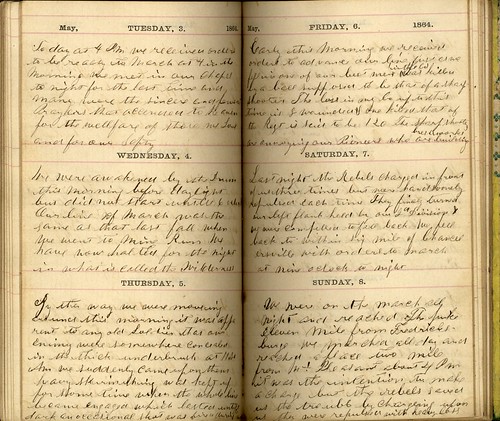-Private Jesse Easton Bump, May 3, 1864
The Littlejohn Collection at Wofford College is home to the journal of Private Jesse Easton Bump, a Union soldier during the American Civil War. Bump was a soldier in the 119th Regiment, or the Pennsylvania “Gray Reserves.” He wrote a short entry almost everyday between September 1863 and August 1864. The entries below describe Bump’s experience during the Battle of the Wilderness which took place near Orange County, Virginia from May 5 to May 7.
The Battle of the Wilderness was the beginning of Lieutenant General Ulysses S. Grant’s Overland Campaign. The objective of the battle was to gain possession of General Robert E. Lee’s Army of Northern Virginia. The Union and Confederate armies had spent the winter in close proximity; the Confederates were camped on one side of the Rapidan River at Mine Run and the Union army on the other side of the river near Culpeper.1Private Bump and the rest of the VI Corps left their winter camp and crossed the Rapidan River on May 4, 1864. He wrote in his journal,
We were awakened by the drum this morning before daylight but did not start until 6 o clock[.] Our line of march was the same as that last fall when we went to Mine Run[.] We have now halted for the night in what is called the Wilderness[.]
In order to avoid the strongly fortified Confederate camp at Mine Run, Grant decided the Army of the Potomac would have to fight in the wilderness surrounding the Rapidan River. The Wilderness was riddled with gullies and tangled underbrush. An individual would find the terrain difficult to move through, yet Grant ordered an entire army to march through it. Because of the wild landscape heavy artillery and cavalry (which were among Grant’s main advantages against the Confederates) could not be used effectively.2
By the way we were moveing [sic] around this morning it was apparent to any old Soldier that our enimy [sic] were somewhere concealed in the thick underbrush[.] at 11,30 Am we suddenly came upon them[.] heavy skirmishing was kept up for some time when the whole line became engaged which lasted until dark[.] an occasional shot was fired during the night[.]
By late morning on May 5, Grant sent VI Corps to hold the strategic Orange Plank and Brock crossroads at any cost until reinforcements could arrive.5 The battle was unlike any the soldiers had seen so far. The wild landscape made fighting more chaotic than usual; lines between divisions blurred among the tall trees and the dry forest caught fire on many occasions. Bump’s journal entry on May 6 details the number of men lost in the Wilderness:
Early this morning we received orders to advance our line first[.] as we fell in one of our best men (in the Co) was killed by a ball supposed to be that of a sharp shooter[.] The loss in my Camp to this time is 8 wounded one killed[.] that of the Regt is said to be 120[.] The sharp shooters are annoying our Pioneers who are building brestworks [sic]
By the end of the battle, about 15,000 Union soldiers were killed, wounded, or missing. The Confederates lost about 11,400.6
Neither side was able to gain a permanent advantage by the second day of fighting because everyone had trouble maneuvering and maintaining order.7 In a last attempt, Ewell ordered a surprise attack on VI Corps on May 6, but the Confederates quickly became disorganized and struggled to gain their objective. Bump recounted these events the next morning in his journal:
Last night the Rebels charged in front of us three times but were handsomely repulsed each time[.] They finally turned our left flank held by our 2d Division & we were compelled to fall back we fell back to within six mile of Chancelersville [sic] with orders to march at nine o clock to night[.]
As Bump states in his journal, Grant ordered the soldiers to prepare for a night march on May 7. The Army of the Potomac was to move to Spotsylvania,Virginia in order to gain an advantage: the open fields surrounding Spotsylvania would be better for fighting and, if held, would be important in securing Richmond, the Confederate capitol. Already exhausted from two days of hard fighting, the army marched all night to Spotsylvania where fighting continued.
- Hannah Jarrett '12
1 Joseph P. Cullen, “Battle of the Wilderness,” Wilderness and Spotsylvania, Harrisburg: Eastern Acorn Press, 1985, p. 4.
2 ibid.
3Cullen, p. 5.
4 Noah Andre Trudeau, “Battle of the Wilderness.”
5 Cullen, p. 9.
6 Cullen, p. 15.
7 ibid.






No comments:
Post a Comment